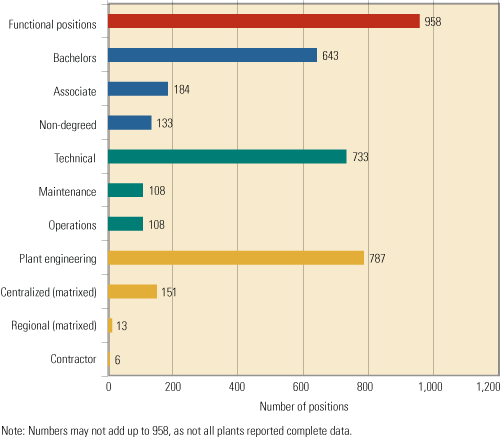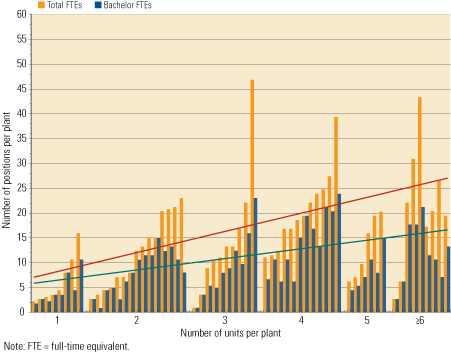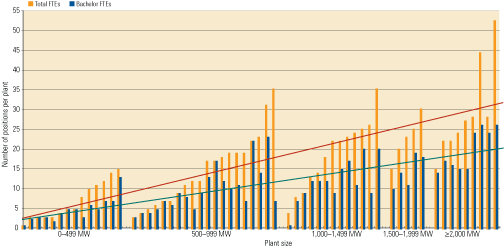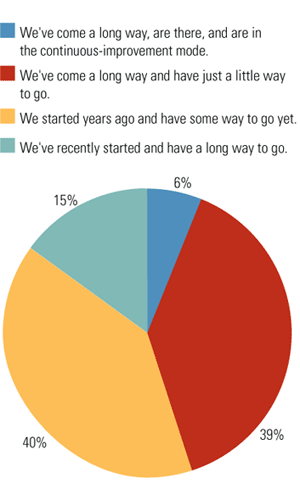Profiling your plant engineering staff
The well-received coal-fired plant operator staffing benchmarking study published in POWER in September 2004 by the EUCG was recently joined by two additional studies: one of plant-level engineering and technical staff and the other of central engineering staffs. This article summarizes the results of the former. A future article will summarize the central engineering staffing study.
Most plant technical staffs represent a diverse mix of experience and capabilities. Some new hires are awarded the title "engineer" on the basis of their education, but they only really earn it under fire. Those suited to the power profession learn how to thrive in the high-pressure cauldron of plant operations; others leave to find employment more tailored to their tastes. But all learn that completing college means your education is just beginning.
Still others become engineers and technicians by starting at the bottom (often as a "rover" on the midnight shift) and rising through the ranks by doing their job well. By way of proof that experience is indeed the best teacher, engineers who have graduated from the school of hard knocks are highly valued because they have seen it all.
Those of you familiar with plant operations are likely to draw the following overall conclusion from the top-level study results presented here: Staffs featuring a mix of engineering and technical (E&T) pedigrees have become a fact of life at most plants. Without question, determining the roles that education, experience, and personalities play in that mix is one of the most important long-term decisions that any plant manager must make.
The study’s scope
The EUCG’s brand-new plant engineering and technical staffing benchmarking study was based on data received from 62 plants with a total of 217 units. Ranging in size from less than 500 MW (22%) to over 2,000 MW (15%), most of the plants are owned by one of 17 geographically diverse utilities. Some 92% of the plants are coal-fired, 8% burn gas or oil, and 69% consider themselves baseload generators. Of the coal-fired units, 52% report that that their fuel mix includes at least 50% Powder River Basin (PRB) coal or lignite.
Other characteristics of the study population provide deeper insight into E&T staffing needs. For example, only 11% of respondents said their plant uses a flue gas desulfurization (FGD) system, whereas 20% report operating a selective catalytic reduction (SCR) system. Surprisingly, only 81% said their plant is equipped with a distributed control system (DCS). One in three respondents claimed their plant’s equivalent availability factor was greater than 90% last year, while almost as many (31%) said it fell between 85% and 90%.
Size vs. smarts
At their 62 plants, respondents reported a total of 1,034 full-time equivalent (FTE) positions on plant engineering and/or technical staff. Of those FTEs, there were actually 958 functional positions. Figure 1 breaks down that number in each of three categories: the staffer’s education, his or her department, and the type of organization to which the staffer belongs. As one might expect, close to two-thirds of the E&T positions are held by engineers with four-year degrees.

1. Functional engineering and technical positions by education (blue), department (green), and organizational type (yellow). Source: EUCG

2. Staff size and education vs. plant unit count. Source: EUCG

3. Staff size and education vs. plant size. Source: EUCG
The detailed plant E&T benchmarking study drills even deeper into the data. Available plots delineate staff characteristics by individual utility (which are assigned a code number, rather than named), by plants with three and four units, and by the level of labor-intensive activity (such as the care and feeding of an FGD or SCR system) at a plant. Remember, only by participating in the study can you gain access to all the raw data you’ll need to benchmark yourself against your closest peers.
Plant 911
Some plant organizations are fully self-contained and have the expertise and experience to handle routine maintenance and overhauls. Others have pulled those resources into a central E&T organization from which subject matter experts (SME) can advise the entire fleet. The rationale for centralization may be cost savings, the desire to standardize business processes, or a response to the well-documented aging of the utility workforce, which continues to take its toll on the supply of SMEs.
Geographic allocation of technical resources is now fairly common at larger utilities. For some with a very large service territory, the hierarchy may even have another level: regional E&T organizations dedicated to specific plants. Across all types of organization, 71% of respondents said they have "robust" centralized or regional technical resources to call on, while 27% said their access to these resources is limited.
Plant-level E&T organizations, especially those serving plants with multiple units, tend to have more specialists than plants of lower rating and unit count. In fact, the study population reported that 65% of their E&T staffs are organized around plant systems vs. only 19% around a specific unit. Only 16% answered "other" to the question of support responsibility, meaning that their E&T organization probably handles problems on a plantwide basis.
Comments from the "other" category included "all personnel support all units and systems, as required," "work on the entire plant," and "structured to support plant equipment, systems, and projects." Taken as a whole, these results and comments suggest that the U.S. electric utility industry may now be pushing E&T talent to become specialists rather than generalists, as was the case a generation ago.
Plants, people aging together
Cultivating and keeping experienced plant technical talent is a never-ending chore for plant managers. We hire go-getters and then wonder why—after getting a few years’ experience under their belts and finally becoming valuable contributors to the E&T team—they hat up and head for greener pastures.
The results of this latest EUCG benchmarking study pretty much repeat what you’ve probably seen elsewhere: 62% of E&T staffers have worked in a plant for 10 to 20 years, with 24% able to claim more than two decades of experience. Overall, 86% of the E&T staffers at responding plants said they have more than 10 years’ experience, 11% said their career in power has been shorter than 10 years, and 3% have been in the field less than five years. Clearly, the plant experience pyramid has been turned upside down.
One area where experience is highly valued because it’s tough to come by is plant control systems. Some 32% of respondents noted that their generating units are controlled by systems that are 10 to 20 years old; another 10% said theirs is twenty-something. Maintaining antiquated controls is very labor-intensive, and at the typical older plant the control systems are kept alive by those who saw the plant commissioned. You can’t easily replace that experience.
Finally, only one-fifth of respondents noted that they are using neural networks for monitoring or controlling their units. Of course, without a DCS, a neural net is not in your future. Conversely, among those who reported using a neural net system (13 plants), it was unanimous that additional E&T support is needed to extract the desired benefits.
New plant order
The survey results also imply that the lines between engineer and technologist have blurred. Roughly 23% of respondents noted that they actively recruit degreed engineers for nontraditional plant positions such as O&M supervisor or I&C foreman. The path to becoming a plant engineer also seems to favor on-the-job performance over formal education. Two examples make that clear: Only 3% of responding plant engineers said they were required to obtain a Professional Engineer’s license, and only 2% of plant technicians said they have some sort of professional certification.
When it comes to managing overhauls and long-term work planning, one-fifth of responding plants get little or no outside support. That’s consistent with the number of respondents who noted the scarcity of central or regional E&T assistance available to help them solve problems and execute plant projects.
Almost one-third of those surveyed said that inside- and outside-the-plant support are equally responsible for long-term planning for major inspections and overhaul outages; one-half said they "do it themselves" with minor outside support. Two-thirds of respondents reported that either the plant engineer, the plant maintenance supervisor, or a member of the plant’s senior staff oversees management of planned outages; for forced outages, the number rises slightly, to 71%. Those speaking for just over one-half (54%) of the reporting plants say they have a full-time person with the title of outage manager.
Calling for help
E&T assistance also can take other forms, such as a permanent on-site technical assistance liaison with a major supplier or a maintenance alliance partner. Some 45% of respondents (higher than expected) said their plant has some form of third-party support relationship.
However, only 13% said that their plant is monitored by an off-site operations center that also provides data monitoring and trending services. A small percentage noted that specific systems (the steam turbine, the furnace) are monitored off-site. Finally, only 24% reported using a heat rate software program to monitor unit heat rates in real time or "near real time." By contrast, 47% said they conduct a formal unit heat rate test on a routine or pre-overhaul basis.
One step at a time
One question asked of the study population was, "What statement best characterizes your plant’s journey to maintenance excellence?" The responses (Figure 4) clearly indicate that we remain our own worst critics when it comes to reporting progress at the plant level. Nonetheless, self-criticism can be useful—as motivation for striving to do the best job possible with the resources available.

4. How respondents describe their plant’s journey to maintenance excellence. Source: EUCG